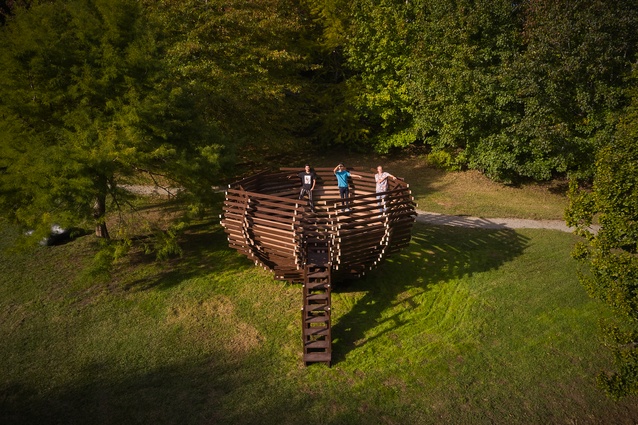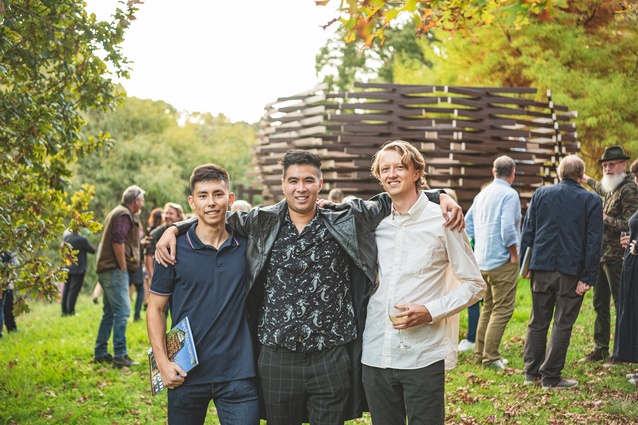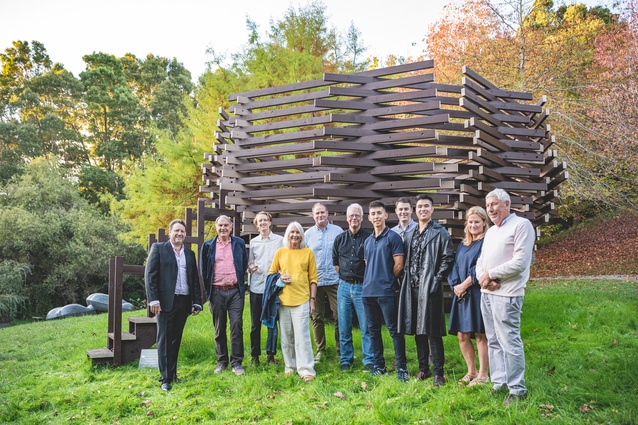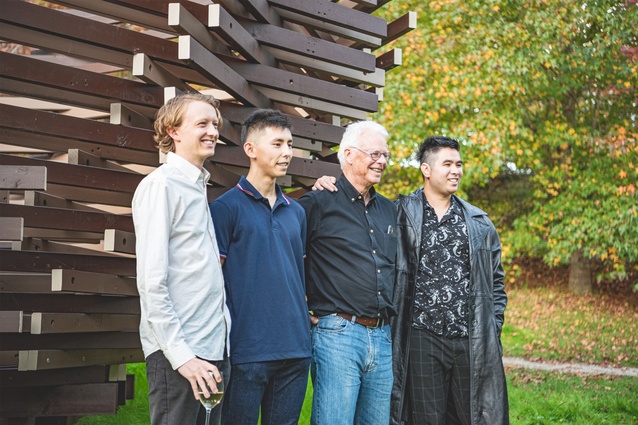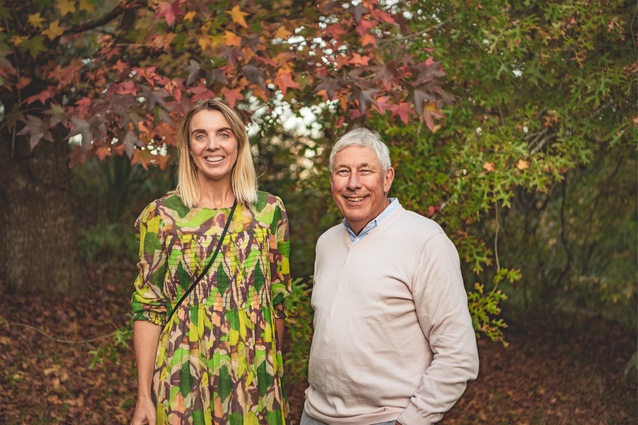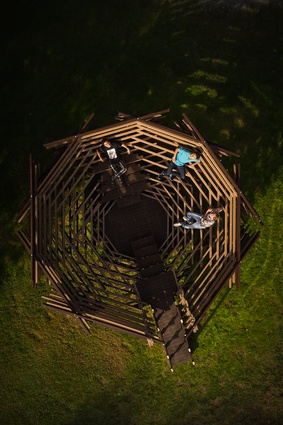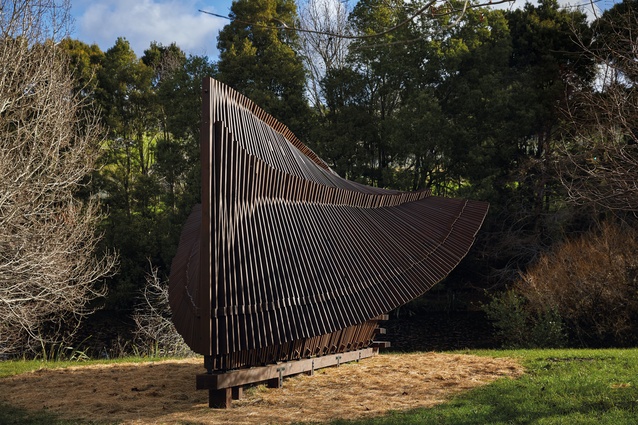Pioneering a second life and beyond
This year’s winning Brick Bay Folly, The Nest, was built almost entirely from recycled timber. Amanda Harkness talks to the team about the challenges this posed.
First, came the large, shaggy Belly of the Beast. Then followed an oversized, eel trap-inspired Daughter of the Swamp, a striking Māori palisade Te Takitaki, the whale-like Jonah, a contemplative The Wood Pavilion and the towering Genealogy of the Pacific. All were beautiful, whimsical, arresting and fanciful. But, by name and by nature, they were follies – relatively costly ornamental buildings with little practical purpose.
Today, as we “hurtle towards the climate change danger zone, with our brakes only half-pulled” (1), we must ask: How do we limit material use and potential waste to landfill while continuing to create, offer and learn from initiatives such as the Brick Bay Folly design competition?
This life-cycle analysis thinking was clearly top of mind for the latest folly winners – Nicholas Rowsby, Brandon Carter-Chan and Joseph Trace, all University of Auckland MArch students – who designed and built The Nest almost entirely from the deconstruction of predecessor, The Wood Pavilion.
The team admits that, when it first visited the sculpture trail at Brick Bay, its thinking was to come up with something new. “We were considering the practice of basket weaving,” says Trace. “It’s well tied to vineyards, historically, where the cuttings and off-trails are tied and stripped of their leaves, and then the binds of that are woven, as a bird would weave its nest.”
“But, with the current timber shortage, we felt the timber already on the site couldn’t go to waste and we wanted to find a way to give it a second life through an adaptive reuse scheme,” says Carter-Chan. “Just as Brick Bay visually changes throughout the seasons, we thought about how we could evolve what is already there, in a similar transitional approach.”
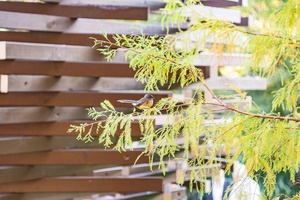
Surrounded by pīwakakwaka (fantails), the design thinking soon moved to contextual architecture and creating a folly that represented a bird’s home. Having been in the same university year-group as the designers of The Wood Pavilion, they approached that group for a list of dimensions.
Plans were created to build the folly based on recycling the available timber. The team’s mentors suggested their first design was too large and perhaps, too structurally ambitious. “Our original proposal was a model with a single skin, like a bowl rim, which fanned out quite a lot,” says Trace. “After feedback on some things that could be changed and taken into consideration, we altered it quite drastically, bringing the whole thing into a tight, almost-closed ball, creating a more-rigid structure with a double skin along the outside.”
It turns out the students had gone too far and had lost some of the appeal of the original open and dynamic form, so they redesigned, “finding a sweet spot” somewhere between the two iterations.
Mentors Peter Boardman, Pip Cheshire, Philip Haycock and Richard Didsbury all took part in the initial design conversations. “We took their feedback quite literally,” says Carter-Chan, “and then Pip told us, when you design something, stay true to your design, even though people critique it. That was really awesome because, as students, we’re still very much open to taking suggestions but Pip was saying stay strong to your ideas, as much as you can.”
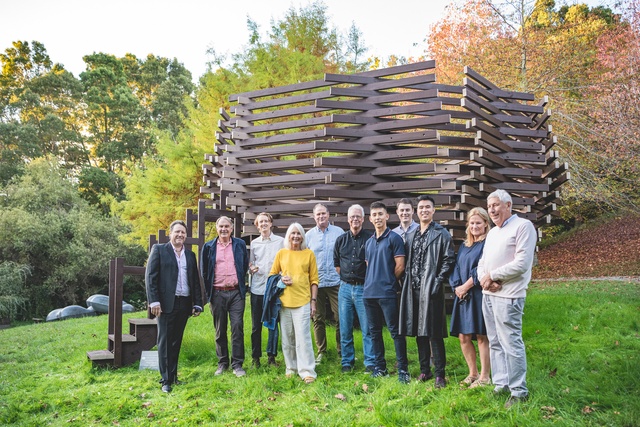
The third, and final, iteration was presented as the country went into lockdown. Boardman gave the students advice over Zoom, while creating his own version of some of the layers to determine structural viability.
Overall, says Trace, things were looking very positive. “There were considerations in terms of calculations that needed to be made, especially regarding a structure that doesn’t just go up but that will be covered in live loads. We had some experience of that in our studies but, when it came to making a structure in a way that is very different to the traditional ways of building in New Zealand, our knowledge was less applicable.”
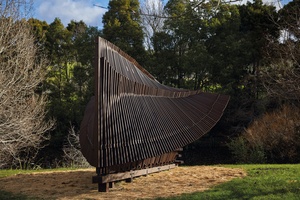
While initial drawings had been based on the dimensions supplied for The Wood Pavilion, “there ended up being twice as much timber as we had originally accounted for,” says Trace. “Which was great because it had gone through two years of weathering so there were numerous pieces that had crowned and bowed and others with big boltholes drilled into them, or with knots or cracks in the timber.”
When compared to some of the past builds, this was particularly challenging. Firstly, the previous folly had to be pulled apart and the pieces used again and, secondly, all physical onsite work had to be conducted between lockdown periods under strict Covid rules.
The difficult week-long deconstruction began in October last year. “We negotiated with a builder to use a pulley system to bring the previous folly down into sections we could salvage,” says Rowsby. “We had to use hand drills and, at one point, Brick Bay property manager Brian Breen even suggested we use an Allen key with a metal bar to carefully unscrew every screw that was in the timber, to save as much as possible. Some segments were put together so well we wouldn’t prise them apart.”
“It would be nice to say the process was therapeutic,” says Trace, “but it wasn’t. At one point we had to use vice grips and pliers just to grab onto the screws. It was a challenge.”
The timber was catalogued and photographed, with images sent to the mentoring team to find out which pieces were useable and which could be cut down to size. “When we made the model and we laser cut those pieces, it was really easy to sort them into piles but when they are three metres long, it’s a mission just picking one up on your own. For us, that really contextualised the scale of architecture,” says Rowsby.
Each of the layers was cut to size, pre-drilled, painted and numbered, to indicate its position in the structure. Onsite installation took place over a six-week period, from early February to mid-March, with the invalueable assistance of Unitec technician Keith Mann.
The move to recycle was undeniably bold and, most likely, pivotal to the win. As Rowsby points out, there was “an insane amount of timber” used in The Wood Pavilion and the fact that the students managed to save and catalogue 797 linear metres for the 746 linear metres needed for The Nest was a feat. The final construction was made up of approximately 95 per cent recycled timber. Carter-Chan sums it up well: “The project has inspired us to consider the possibility that materials can have second lives. And we like the idea that this latest iteration will perhaps have a third life.”
Brick Bay Folly is sponsored by Resene, Naylor Love, Brick Bay, Cheshire Architects, Unitec, Structure Design, Architecture NZ, ArchitectureNow and Sam Hartnett Photography. This year’s judges were Pip Cheshire from Cheshire Architects, Philip Haycock from Naylor Love, Karmen Dumper from Resene, Yusef Patel from Unitec, Peter Boardman from Structure Design, Chris Barton from Architecture NZ, Richard and Anna Didsbury from Brick Bay, and Raymond Yoo from the 2020/21 winning Folly team, whose folly was named Genealogy of the Pacific.
Reference
1. UN Secretary-General Antonio Guterres comment on the Intergovernmental Panel on Climate Change Report.

